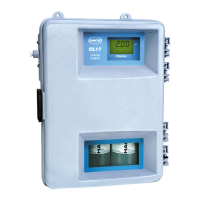General Information
Page 59
54400_desc.fm General Information
Principle of Operation
The analyzer is designed to capture and analyze a portion of the sample
every 2.5 minutes. The sample portion is captured in the colorimeter
measuring cell where the blank absorbance is measured. Measurement of
sample blank absorbance allows compensation for any turbidity or natural
color in the sample, and provides an automatic zero reference point.
Reagents are added at this point to develop the magenta color, which is
measured and compared to the reference.
A linear peristaltic pump/valve module controls the flow of incoming sample
and injects metered volumes of the buffer and indicator reagents in a
2.5 minute cycle. The pump/valve module uses a motor-driven cam to operate
pinch blocks that squeeze special thick-walled tubing against a fixed plate.
The cycle operates as follows:
1. The sample inlet line is opened, allowing sample under pressure to flush
sample tubing and the colorimeter sample cell where the measurement
is made.
2. The sample inlet line is closed, leaving fresh sample in the cell. Cell
volume is controlled by an overflow weir.
3. As the sample inlet line closes, reagent lines open, allowing buffer and
indicator solutions to fill tubing in pump/valve module.
4. A measurement of untreated sample is taken to determine an average
reference measurement prior to reagent addition.
5. The reagent outlet block opens, allowing buffer and indicator to blend and
enter the colorimeter cell to mix with the sample.
6. After a delay for the development of color, a measurement of treated
sample is taken to determine the chlorine concentration.
This sequence is repeated every 2.5 minutes.

